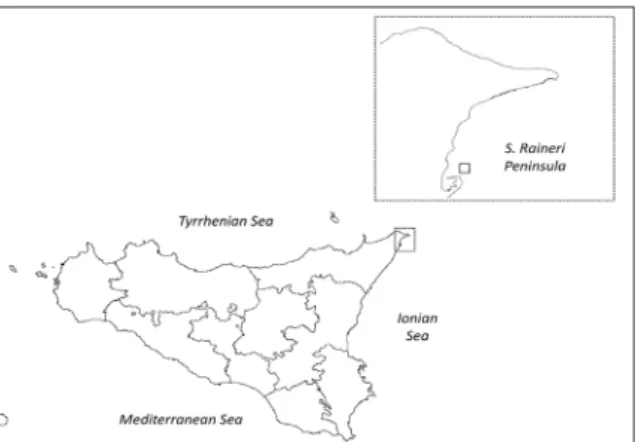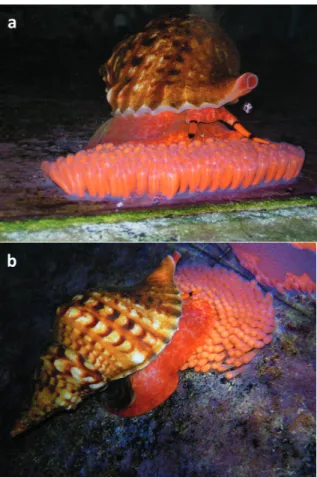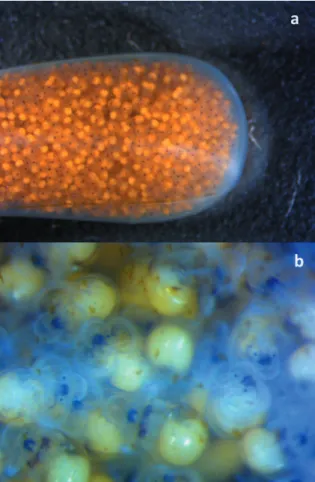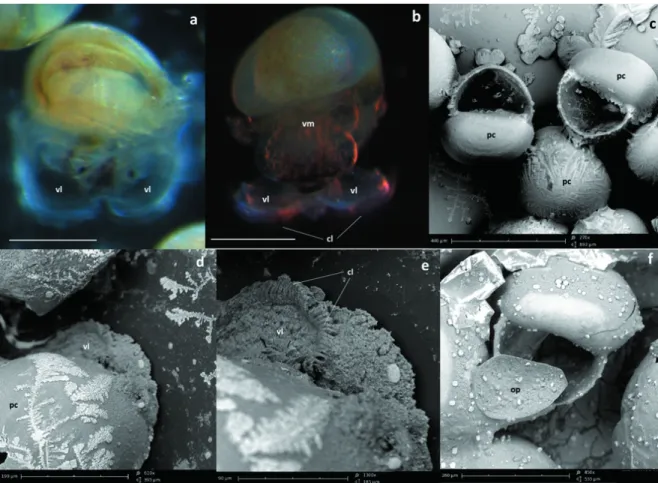Mediterranean triton Charonia lampas lampas (Gastropoda:
Caenogastropoda): report on captive breeding
Mauro CAVALLARO*
1, Enrico NAVARRA
2, Annalisa DANZÉ
2, Giuseppa DANZÈ
2,
Daniele MUSCOLINO
1and Filippo GIARRATANA
11Department of Veterinary Sciences, University of Messina, Polo Universitario dell’Annunziata, 98168 Messina, Italy
2Associazione KURMA, via Andria 8, c/o Acquario Comunale di Messina-CESPOM, 98123 Messina, Italy
*Corresponding author: [email protected]
INTRODUCTION
The triton Charonia seguenzae (ARADAS & BENOIT, 1870), in the past reported as Charonia
variegata (CLENCH AND TURNER, 1957) or
Cha-ronia tritonis variegata (BEU, 1970), was recently classified as a separate species present only in the Eastern Mediterranean Sea (BEU, 2010).
Gastropods of this genus are rare and occa-sionally extinct due to over-fishing, for human consumption and, unfortunately as decorative objects (HOSKING, 1996; KANG AND KIM, 2004; KATSANEVAKIS et al., 2008; MCLEAN, 1999; RUSSO
et al, 1990; WANG, 1997). In the Mediterranean Sea,
two allopatric species, Charonia lampas and C.
seguenzae, are present respectively distributed
in the Western in the Eastern Mediterranean with probable co-occurrence in Malta (BEU, 1985, 1987, 2010).
The Gastropod Charonia lampas lampas (Linnaeus, 1758) is a large Mediterranean Sea and Eastern Atlantic carnivorous mollusk from the Ranellidae family, Tonnoidea superfamily, Caenogastropoda.
Although C. lampas is not listed under the IUCN (2012) red-list, species are protected accord-ing to Annex II of the Bern convention (COUN-CIL OF EUROPE, 1979) and the Protocol of the Barcelona convention (EUROPEAN COMMUNITY, 1999) because it is species at risk of extinction and it would be desirable the creation of cap-tivity breeding programs, in order to allow the
Two females and a male triton of Charonia lampas lampas (Linnaeus, 1758) were collected from March 2010 to September 2012 in S. Raineri peninsula in Messina, (Sicily, Italy). They were reared in a tank at the Aquarium of Messina. Mussels, starfish, and holothurians were provided as feed for the tritons. Spawning occurred in November 2012, lasted for 15 days, yielding a total number of 500 egg capsules, with approximately 2.0-3.0 x 103 eggs/capsule. The snail did not eat during the month, in which spawned. Spawning behaviour and larval development of the triton was described. Key words: Charonia lampas lampas, Gastropod, triton, veliger, reproduction
“conservation and/or, where appropriate, captive breeding, repopulation or reintroduction of spe-cies into the wild”. Capture, however is rarely followed by release (KATSANEVAKIS et al., 2008).
Protection of Charonia populations also requires solid knowledge of the biology and ecology, which can be further improved by stud-ies on the maintenance and breeding in captivity and, despite the ecological importance of this specie, the information on its reproductive biol-ogy are very limited in spite of some referring to nutrition as reported by (BIRKELAND & LUCAS, 1990; KANG & KIM, 2004; LAXTON, 1971; PER-CHARDE, 1972; RUSSO et al., 1990). Furthermore, a recent study (DOXA et al., 2013 a e b) describe that
C. seguenzae, shows a high ability for feeding
adaptation in captivity, as individuals consumed a large variety of species.
The only information available from the period of reproduction in the Mediterranean Sea is that reported by Lo Bianco (1888) that observed, in an aquarium of the Zoological Station of Naples, some specimens of C.
lam-pas coupling two times a year (December and
June). He also observed egg deposition and describes them as abundant and enclosed in numerous club-shaped capsules (some hundreds of eggs per capsule). Furthermore, AMOUROUX (1974) has observed in Aquarium spawning to be induced by the quality of food, in particular after feeding a particular type of prey. In 1988 GHISOTTI describes a case of ovodeposition in the Aquarium of Castel Dragone di Camogli (Italy), where only a big female was present.
The first report on the captive reproduction of triton (Charonia tritonis), was performed by Berg, 1971 who described the production of eggs and veliger from a female maintained in a culture vessel, obtained from diving in Phuket (Thailand) (NUGRANAD et al., 2000). Recently embryogenesis and early larval development were widely described by LÜ-PING et al. (2013).
This report describes the biological behav-iour of three specimens of triton (two female and one male) lived in captivity at the Aquarium of Messina (Sicily, Italy). Data on food and feed-ing, spawnfeed-ing, management and species restock are reported in order to improve the knowledge on C. lampas.
MATERIAL AND METHODS
Broodstock collectionTwo females and a male triton of Charonia
lampas lampas (Linnaeus, 1758) were collected
from the S. Raineri Peninsula (+38° 11’ 38.01”, +15° 34’ 25.69”) in the Straits of Messina (Fig. 1), at a depth of about 35 metres on a sandy bottom. All specimens were kept in a box with seawater and artificial aeration and transported to the Municipal Aquarium of Messina. The first female (1-♀) was transported in March 2010; the second female (2-♀) and the male (3-♂) in February 2011 and in September 2012 respec-tively (Fig. 2). At the laboratory of Aquarium of Messina all specimens were measured (Fig. 3) according to Nateewathana and Aungtonya method (1994) as shown in Tab. 1.
Fig. 1. S. Raineri Peninsula, Messina Italy: the □ indicates the site where the specimens were captured (+38° 11’ 38.01”, +15° 34’ 25.69”).
Fig. 2. Specimens of Charonia lampas lampas (Linnaeus, 1758): a) male (3-♂); b) female (1-♀); c) female (2-♀)
Culture tanks
All specimens were maintained at the Aquar-ium (Fig. 4) in an open system tank (tank A) with a capacity of 23000 litres. In February 2012 the females were transferred in a open system tank (tank B) with a capacity of 2200 litres, with a checked temperature of 15±2°C. Parameters of water include pH 8.0, nitrites absent and nitrates concentration of 6 mg/l. On September 2012 the male was also transferred.
Food and feeding
The tritons were fed with a mix of sea star (Echinaster sp.), sea cucumbers (Holothuria sp.) and Mediterranean mussels (Mytilus
gallopro-vincialis). All specimens of C. lampas did not
feed during the month in which spawned.
Table 1 Data on 3 broodstock of Charonia lampas at arrival at Aquarium of Messina
Broodstock data C. lampas 1 C. lampas 2 C. lampas 3
Date arrival in Aquarium March 2010 February 2011 September 2012
Total shell length (TL) cm 21 19 19
Width of body whorl (WB) cm 10.5 9.5 9
Length of body whorl (LB) cm 12 11.5 11
Length of spire (LS) cm 9.5 8 9
Length of aperture (LA) cm 9.5 8.5 8.5
Total weight in g 580 560 410
Sex female female male
Condition at arrival Good Good Good
Fig. 3. Measurement scheme for Charonia lampas lampas
Reproduction and larval culture
Triton’s behavior was continuously moni-tored. Data on mating and spawning behavior were recorded. Egg capsules were counted. After deposition some egg capsules were col-lected and transferred into the hatchery for measurement and to observe their development.
The incubation and the hatching of veligers were performed in 40-litres fiberglass tank (tank C) provided with natural light, clean sea water and gentle aeration. Thirty percentage of sea water was changed every 4 days. The larvae were fed with cultured unicellular phytoplank-ton Dupla Rin® supplied by Dohse Aquaristik
GmbH & Co (Grafschaft, Germany). It contains
Spirulina, Laminaria, Chlorella, protein,
essen-tial oligo elements, omega-3 fatty acids, Cyclop
eeze, astaxantina, beta-glucan, enriched with
vitamin A, B1, B 2, B 3, B 5, B 6, C, E.
Microscope observations
The observations of eggs and veliger were made by using stereomicroscope Leica M205C (Leica, Bensheim, Germany) fitted with a dig-ital camera Leica ICC50 HD (Leica, Benshe-im, Germany). The images were recorded and treated using the stereological analysis software Metamorph, Leica Application Suite (Leica, Bensheim, Germany) for counts and measure-ments of eggs and veliger. Veligers morphology was studied by using a Phenom Scanning Elec-tron Microscopy (SEM) (Phenom-World BV, Eindhoven, The Netherlands).
RESULTS AND DISCUSSION
The two females were kept in the central basin of the Aquarium (open system tank with a capacity of 23000 L) until 25 February 2012 and subsequently kept in a smaller tank of 2200 litres. On 20 September 2012 the male was introduced into. The weekly food consump-tion of the three tritons, during relaying period, was estimated at about 300g/snail. Predation occurred mostly in the evening. No difference in food consumption between male and female were observed. However, the feeding of all
females ceased for months during the egg-laying period. The smaller female (2-♀) began the spawning on 5 November 2012, while the bigger female (1-♀) on 21 November 2012. Spawning lasted for about 20 days. The coupling rituals occurred exclusively at night and lasted for
sev-Fig. 5. Eggs capsules of Charonia lampas on the wall of the tank. Larvae swim inside the capsule and are closed to hatch
Fig. 6. Charonia lampas on egg capsules: a) female (1-♀); b) female (2-♀)
eral hours. The eggs were deposited in long sac-cular capsules of transparent jelly-like material clustered together (Fig. 5). The capsules were 15-20 mm high and 5-7 mm wide. Each capsule contained 2000-3000 bright orange colored eggs with a diameter of 0.30-0.40 mm. The number of egg capsules was about 200 for the little female (2-♀) and about 400 for the big one (1-♀). An average number of 1500 ± 300 veligers hatched for capsule were observed, as reported by Nugranad et al. (2001) for C. tritonis. The females showed a similar behavior in taking care of the egg capsules. After eggs laying, both
Fig. 7. a) egg capsules with free-swimming veligers; b) particular of free-swimming veligers before hatching
Table 2. Data on females activity Starting date
deposition depositionEnd date depositedCapsules hatching capsulesDate of first
End date of hatching
capsules
Female 1 21/11/2012 12/12/2012 414 27/2/2013 17/3/2013
Female 2 5/11/2012 27/11/2012 223 20/3/2013 7/4/2013
females remained on the egg capsules without feeding for many days (brooding behavior). The females, in fact, used their proboscis to clean egg capsules (Fig. 6).
Fertilized eggs developed into capsules. The embryo started to move inside the egg after 10 days. The prehatching veligers swam actively inside the capsules while the jelly content of the capsule became more transparent (Fig. 7).
Details on female 1
The female 1 produced a total of 414 cap-sules. On 27 February 2013, the membrane on the apical portion became thinner, then torn off, making a hole through which the veligers hatched out.
In the same day, two egg capsules were transferred into tank C. The following day the release of the hatching veliger was observed. The egg capsules, in tank B, do not have hatched all at once, but gradually until the 17 March 2013.
Details on female 2
The female 2 produced a total of 223 cap-sules. On 20 March 2013, the membrane on the apical portion became thinner as reported for female 1. Also the egg capsules of female 2 have not hatched all at once, but gradually until the 7 April 2013.
At environment temperatures of 14-16 °C and salinities of 32-34 ‰, the veligers devel-oped and hatched from the capsules, between 12 and 20 weeks after oviposition. The details are summarized in Table 2.
Each capsule contained veligers in different stages of development and size, but hatching from a single capsule occurred in the same day. Newly hatched veligers measured 0.28±0.02 mm at the greatest shell diameter, and had a 4-lobed velum expanded for swimming (Fig. 8).
Survival
After one month from hatching, the sur-vival of veligers was estimated at 40%. Mortal-ity increased over the extended rearing period probably due to a problem of tropism. We have tried to keep diatomee, and Artemia salina and food species of fitoplancton in the tanks with veligers, but settlement was not induced. Shell growth and development of the soft body were obvious, but all veligers remained swimming with no sign of settlement in culture.
Larval production
The number of veliger larvae produced by each female ranged from about 200 000 to more than 800 000. The capsules were properly devel-oped for the entire period of incubation until hatching, involving the 95% of the total.
Fig. 8. Morphological characteristics of the free-swimming veliger of C. lampas: a) free-swimming veliger in frontal view at ten days after hatching, note one pair of velar lobe; b) lateral view, showing one pair of velar lobes, cilia and some visceral mass; c) veliger before hatching showing the original shell in a completed helix; e-d) detailed part of velum and cilia; f) detailed part of the head of veliger before hatching, showing the discoidal operculum.
Legend: ci, cilia. op, operculum. pc, protoconch. vl, velar lobe. vm, visceral mass. Scale bar = 200 μm in a and b
CONCLUSIONS
Adult tritons have been successfully repro-duced in captivity in the structures of the Aquar-ium of Messina. A large number of swimming larvae (veligers) have been obtained, and their development was fine.
The good survival of adult C. lampas in our experimental tank confirms its physiologi-cal adaptability, and as described NASUTION & ROBERTS (2004) for the species Buccinum
undatum that stated the possibility of
introduc-ing this species into aquaculture practices, the same could be done for our species. In fact the consistent timing of egg laying, exhibited by animals living for a long time in an aquarium, at a constant temperature, indicates that internal clocks (FABIOUX et al., 2005) or dependence on
photoperiod (PEARSE et al., 1986; WAYNE, 2001) may synchronize gametogenesis and trig-ger spawning.
However, despite many trials of isolation of larvae in closed controlled environments, no metamorphosis was observed, as well as the transition to benthic life.
This study demonstrated a great adaptation of this species to captivity, considering that tri-tons feed regularly and started coupling rituals after about one month.
Further studies will be necessary to improve the techniques for the production of juveniles.
The larvae of this species, in fact, leave the pelagic life after a long period. Consequently, the critical points of the development have a dif-ficult resolution, in fact, the small dimensions and especially the habits of the trophic veliger, are particularly selective and almost unknown .
After consolidated ex situ breeding tech-niques, could be important to refine and imple-ment the breeding techniques of this species in order to constitute “contingent” of young specimens to be used for experiments aimed at re-entry into easily controlled areas such as marine protected areas.
REFERENCES
AMOUROUX, J.M. 1974. Observations sur la biolo-gie du mollusque Gasteropode Charonia
nodiferus (Lamarck). Vie Milieu, 24 (2-3):
365-368.
BERG, C.J. 1971. Egg capsule and early veliger of
Charonia tritonis (Linnaeus). Veliger, 13:
298-298.
BERN CONVENTION 1979. Convention on the Conservation of European Wildlife and Nat-ural Habitats. Council of EUROPE, Avenue de l’Europe F-67075 Strasbourg, Cedex, France, pp. 1-10
BEU, A.G. 1970. The Mollusca of the Genus Cha-ronia (Family Cymatiidae). Trans. N. Z. Inst., 11: 205–223.
BEU, A.G. 1985. A classification and catalogue of living world Ranellidae (Cymatiidae) and Bursidae. AM Conc, 13: 55–66.
BEU, A.G. 1987. Taxonomy of gastropods of the families Ranellidae (Cymatiidae) and Bur-sidae. Part 1. Adoption of Ranellidae, and review of Linatella Gray, 1857. New Zeal. J. Zool., 13: 241–266.
BEU, A.G. 2010. Neogene tonnoidean gastropods of tropical and South America: contributions to the Dominican Republic and Panama Paleontology projects and uplift of the Cen-tral American Isthmus. Bull. Am. Paleontol., 377–378, 1–550.
BIRKELAND, C. & J.S. LUCAS. 1990.
Acanthast-er planci: Major Management Problem of
Coral Reefs. CRC Press, Boca Raton LA. COUNCIL DIRECTIVE EC n 22 (1999). Relating to
the keeping of wild animals in zoos. Official Journal of the European Communities of 29 March 1999. pp. 24-26.
DOXA, C.K., M. KENTOURI & P. DIVANACH. 2013. Feeding of Charonia seguenzae (Aradas & Benoit, 1870) on natural preys and alterna-tive foods. J. Molluscan Stud. 79: 76–78. DOXA, C.K., P. DIVANACH & M. KENTOURI. 2013.
Consumption rates and digestibility of four food items by the marine gastropod
Cha-ronia seguenzae (Aradas & Benoit, 1870).
Journal of Experimental Marine Biology and Ecology, 446: 10–16.
FABIOUX, C., A. HUVET, P. LE SOUCHU, M. LE PEN-NEC & S. POUVREAU. 2005. Temperature and photoperiod drive Crassostrea gigas repro-ductive internal clock. Aquaculture, 250 (1–2): 458–470.
GHISOTTI, F. 1988. Ovodeposizione in Charonia rubicunda. AQUA, 26: 104-105.
HOSKING, R. 1996. Dictionary of Japanese Food. Tuttle Publishing, Singapore. pp. 127-128. KANG, K.H. & J.M. KIM. 2004. The predation of
trumpet shell, Charonia sp., on eight dif-ferent marine invertebrate species. Aquac. Res., 35: 1–5.
KATSANEVAKIS, S., E. LEFKADITOU, S. GALINOU-MITSOUDI, D. KOUTSOUBAS & A. ZENETOS. 2008. Molluscan species of minor commer-cial interest in Hellenic seas: distribution,
exploitation and conservation status. Medi-terr. Mar. Sci. 9: 77–118.
LAXTON, J.H. 1971. Feeding in some Australasian Cymatiidae (Gastropoda: Prosobranchia). Zool. J. Linn. Soc., 50: 1–9.
LO BIANCO S. 1988. Notizie biologiche riguard-anti specialmente il periodo di maturità ses-suale degli animali del golfo di Napoli. Mit-theilungen a. d. Zoolg. Station zu Neapel, Bd., 8: 385-446.
LÜ-PING, Z., X. JIAN-JUN, P. PENG-FEI, L. HAI-PENG, L. PENG & H. CHAO-QUN. 2013. Charac-terization of embryogenesis and early larval development in the Pacific triton, Charonia
tritonis (Gastropoda: Caenogastropoda). Int.
J. Inver. Rep. Dev., 57: 237-246.
MCLEAN, M. 1999. Weavers of Song: Polynesian Music & Dance. Auckland University Press, Auckland, pp. 212-213.
NATEEWATHANA, A. & C. AUNGTONYA. 1994. The Indo Pacific trumpet triton snail,
Charo-nia tritonis: Morphometrics of a species
on the verge of local extinction. Phuket Marine Biological Center Special Publica-tion. 13:137-140.
NASUTION, S. & D. ROBERTS. 2004. Laboratory tri-als on the effects of different diets on growth and survival of the common whealk,
Buc-cinum undatum L. 1758, as a candidate
spe-cies for aquaculture. Aquacult. Int., 12(6): 509–521.
NUGRANAD, J., S. CHANTRAPORNSILP & T. VARA-PIBAL. 2000. Feeding and spawning behavior of the trumped triton, Charonia tritonis (L., 1758) in captivity. Phuket Marine Biological Center Special Publication, 21: 51-56. NUGRANAD, J., K. PROMJINDA & T. VARAPIBAL.
2001. Reproduction of the trumped triton
Charonia tritonis (Mollusca: Gastropoda) in
captivity. Phuket Marine Biological Center Special Publication, 25: 153-160.
PEARSE, J.S., D.J. EERNISSE, V.B. PEARSE & K.A. BEAUCHAMP. 1986. Photoperiodic regulation of gametogenesis in sea stars, with evidence for an annual calendar independent of fixed daylength. Amer. Zool., 26: 417–431. RUSSO, G.F., G. FASULO, A. TOSCANO & F.
TOSCA-NO. 1990. On the presence of triton species (Charonia spp.) (Mollusca Gastropoda) in the Mediterranean Sea: ecological consid-erations. Boll. Malacol., 26: 91–104
WANG, D.D. 1997. Fin-de-Siecle Splendor: Repressed Modernities of Late Qing Fic-tion, Stanford University Press, Palo Alto, CA, pp. 1849–1911.
WAYNE, N.L. 2001. Regulation of seasonal repro-duction in mollusks. J. Biol. Rhythms, 16(4): 391–402.
Received: 28 July 2015 Accepted: 8 July 2016
Sredozemni morski puž Tritonova truba,
Charonia lampas lampas (Gastropoda: Caenogastropoda):
izvješće o akvarijskom uzgoju
Mauro CAVALLARO*, Enrico NAVARRA, Annalisa DANZÉ, Giuseppa DANZÈ,
Daniele MUSCOLINO i Filippo GIARRATANA
*Kontakt e-adresa: [email protected] SAŽETAK
Dvije ženke i mužjak puža Tritonova truba, Charonia lampas lampas (Linnaeus, 1758) su prikupljeni od ožujka 2010. do rujna 2012. na poluotoku S. Raineri, Messina, (Sicilija, Italija). Ovi primjerci su uzgajani u spremniku akvarija u Messini. Puž Tritonova truba je hranjen s školjkama, zvjezdačama i trpovima. Mrijest se dogodio u studenom 2012. godine, trajao je 15 dana tijekom kojih je izneseno 500 jajčanih kapsula s približno 2.0-3.0 x 103 jaja po kapsuli. Puževi nisu jeli
tijekom mjeseca u kojem se odvijalo mriješćenje. U radu su opisani ponašanje tijekom mrijesta i razvoj ličinke Tritonove trube.
Ključne riječi: Charonia lampas lampas, Gastropodi, puž Tritonova truba, trepetljikasta ličinka




